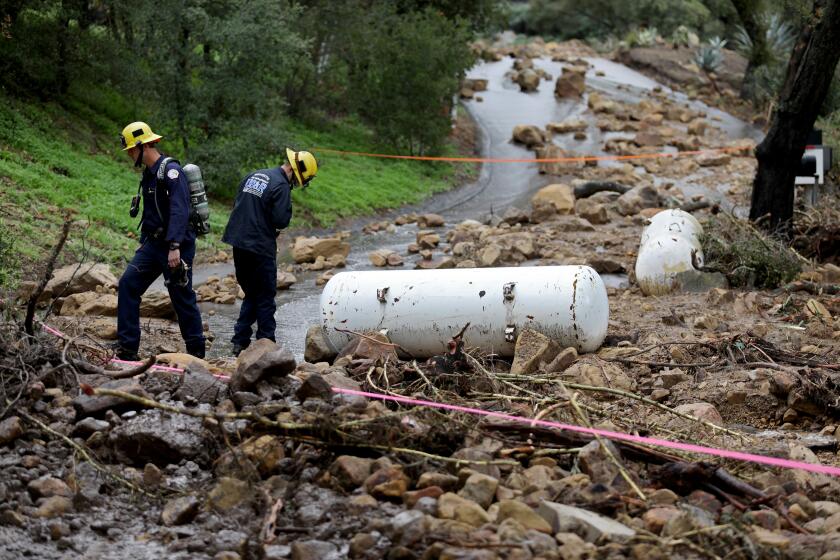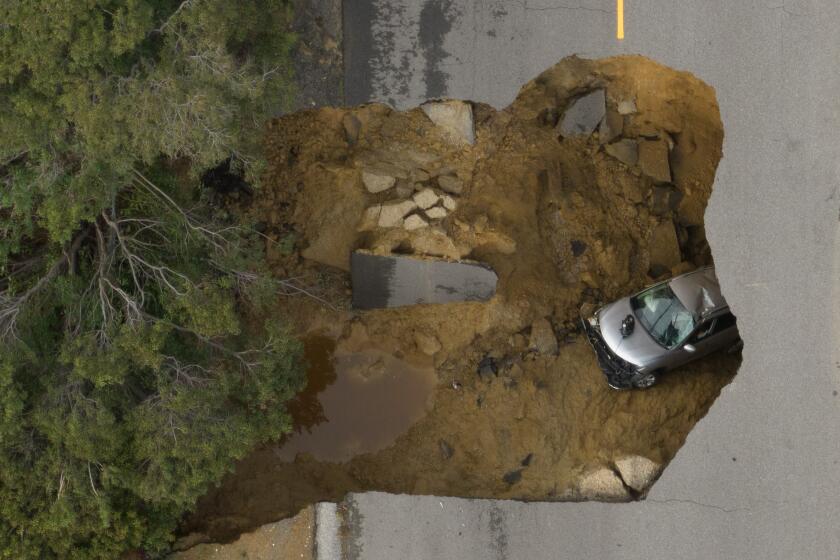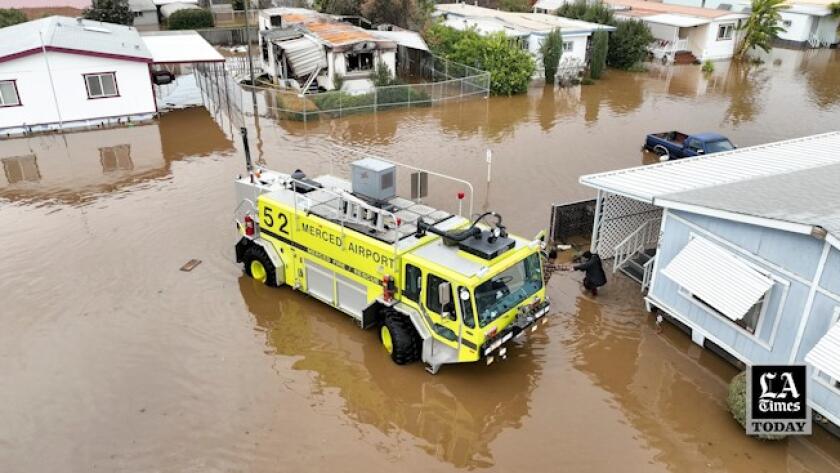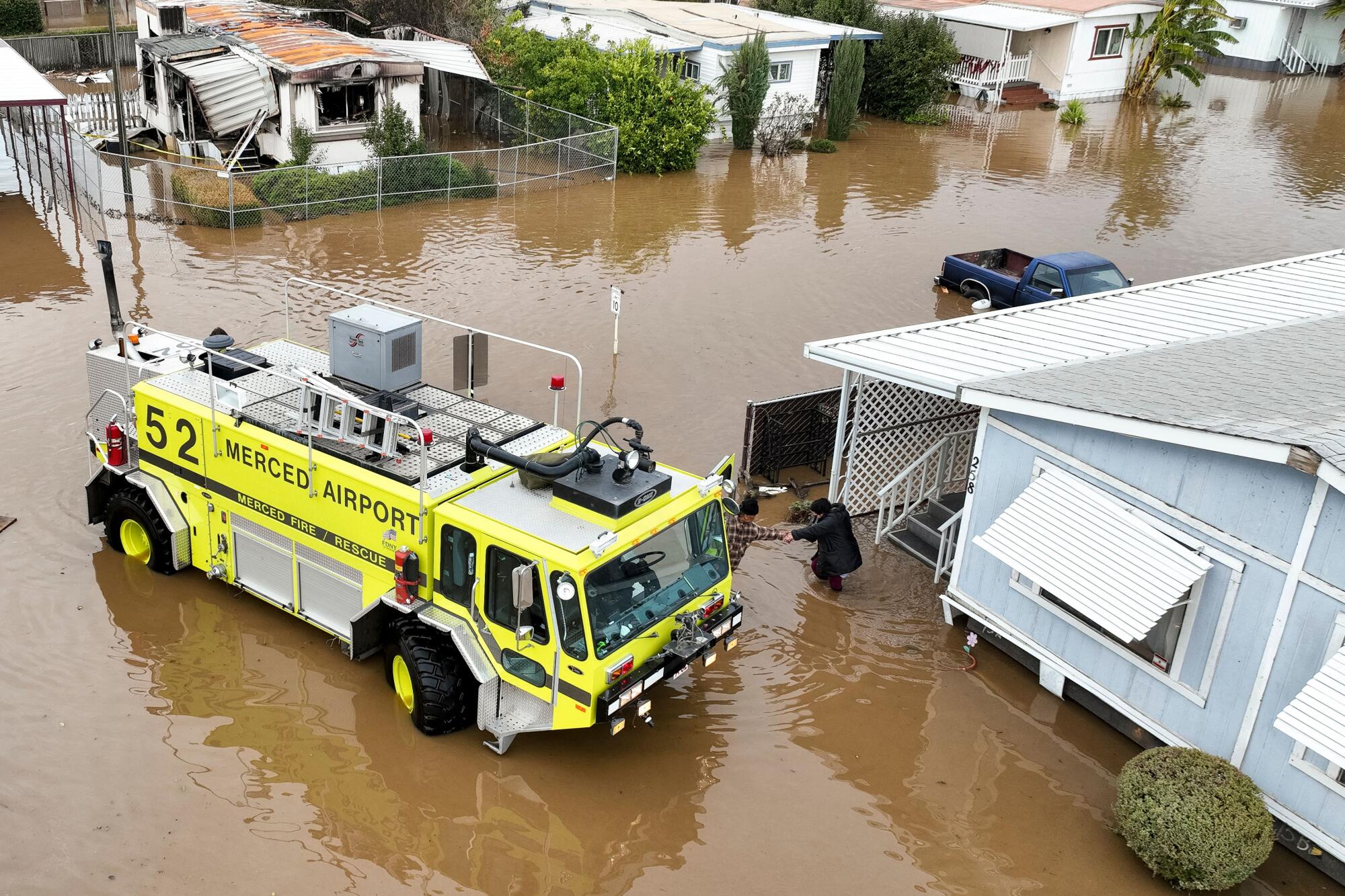
- Share via
The woman clung to a tree in pitch darkness. Nearby, her gray pickup was submerged in murky, brown water.
She was trapped along a fair-weather bridge, a causeway built over Coyote Creek just north of Ventura. The creek had overflowed and flooded the crossing after a powerful storm barreled into the area Monday.
About 100 feet away, voices called out over the rushing water. Hold tight, they told her. A rescue swimmer is coming.
The job of getting the stranded, soaking-wet woman to safety fell to the Ventura County Fire Department’s swift water rescue team. Their tools, rope and a canoe.
Up and down the state, rescue teams such as Ventura’s have come to the aid of people stranded in flooded neighborhoods and trapped in cars after a series of winter storms battered California over the few past weeks.
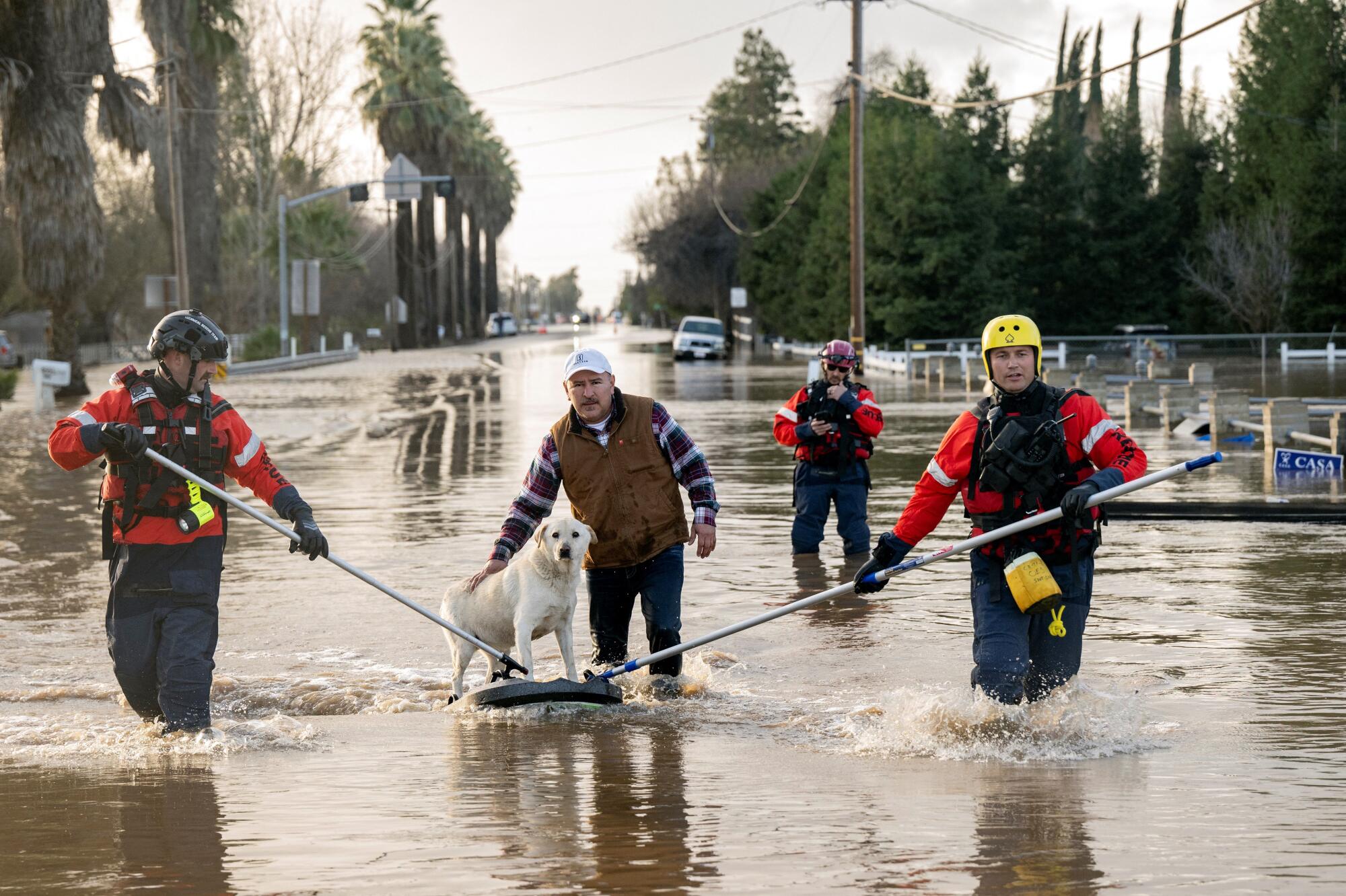
Although hundreds of people have been rescued, there have been at least 19 storm-related deaths in California. Earlier this week, Gov. Gavin Newsom said the storms had claimed “more lives than wildfires in the past two years combined.”
At least 22 have died as a result of California’s recent intense storms, many from drowning and fallen trees.
In summer and fall — and increasingly year round — firefighters battle the wildfires that plague this drought-stricken state. When winter and spring are as wet as California is now, they post up against deluges.
Either way, they’re in a fight against nature.
On Jan. 4, as the first storms began to dump heavy rain, the state’s Office of Emergency Services stationed the Bakersfield Fire Department’s swift water rescue team just outside Sacramento.
As the team waited to be deployed, its six members practiced rescue scenarios on the American River. Then, at around 2:30 a.m. Jan. 9, they received a call: Head to Merced.
With rain-swollen Bear Creek flooding the city’s streets, the team began evacuating whole neighborhoods. Five team members waded out in water that was hip- to chest-high and looked like chocolate milk. The water temperature fell below 50 degrees.
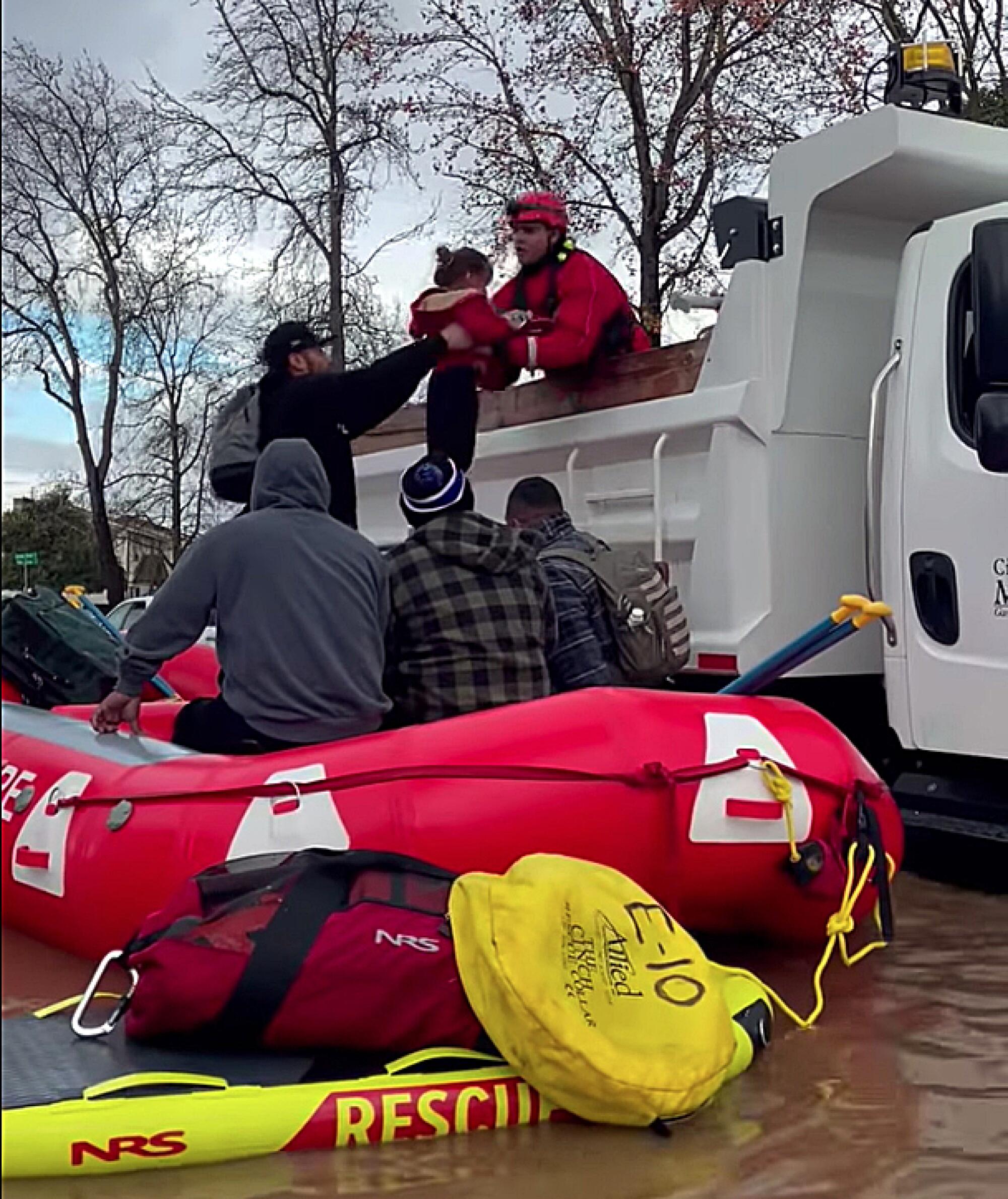
Rescuers wore red and black dry suits, life jackets, boots, helmets and gloves. They towed their boat alongside them as they knocked on doors and offered residents the chance to leave. In some cases, residents faced nearly 2 feet of water in their homes. They packed up grocery bags, duffels and backpacks and brought along their cats, birds and dogs.
“Everybody was very polite, very quick and very grateful that they had an opportunity to get out and get to some dry ground,” said Jason Kingsley, the team leader on the rescue.
As they navigated the streets, Kingsley said, they spotted cars partially floating and others moved by the flowing water and bunched up in the shallows.
At one point, they came across a woman who had accidentally driven down a flooded road and gotten stuck. The water reached about mid-window on her car. The team was able to pull her out through the sunroof, slide her down the hood of the car and get her into the boat — all without her getting wet.
The team evacuated about 50 people that day.
“We train for this type of thing, but training and actually doing it, it’s very different,” said Benjamin Henggeler, a fire captain and task force leader. “It forces you to use all of your skill set of everything that you’ve learned and prepared for.”
Among the dozens of teams deployed by the state during the recent storms was the CAL OES Oakland Fire Department swift water rescue team 4. On Tuesday, the team — which included firefighters from Oakland and outside agencies — did a recon of Salinas, Gilroy and Hollister and visited local fire stations to alert them that they were in the area.
At a little after 10 p.m., they received a call that two men were trapped on the roof of a truck in the San Benito River. The water had reached the windows.
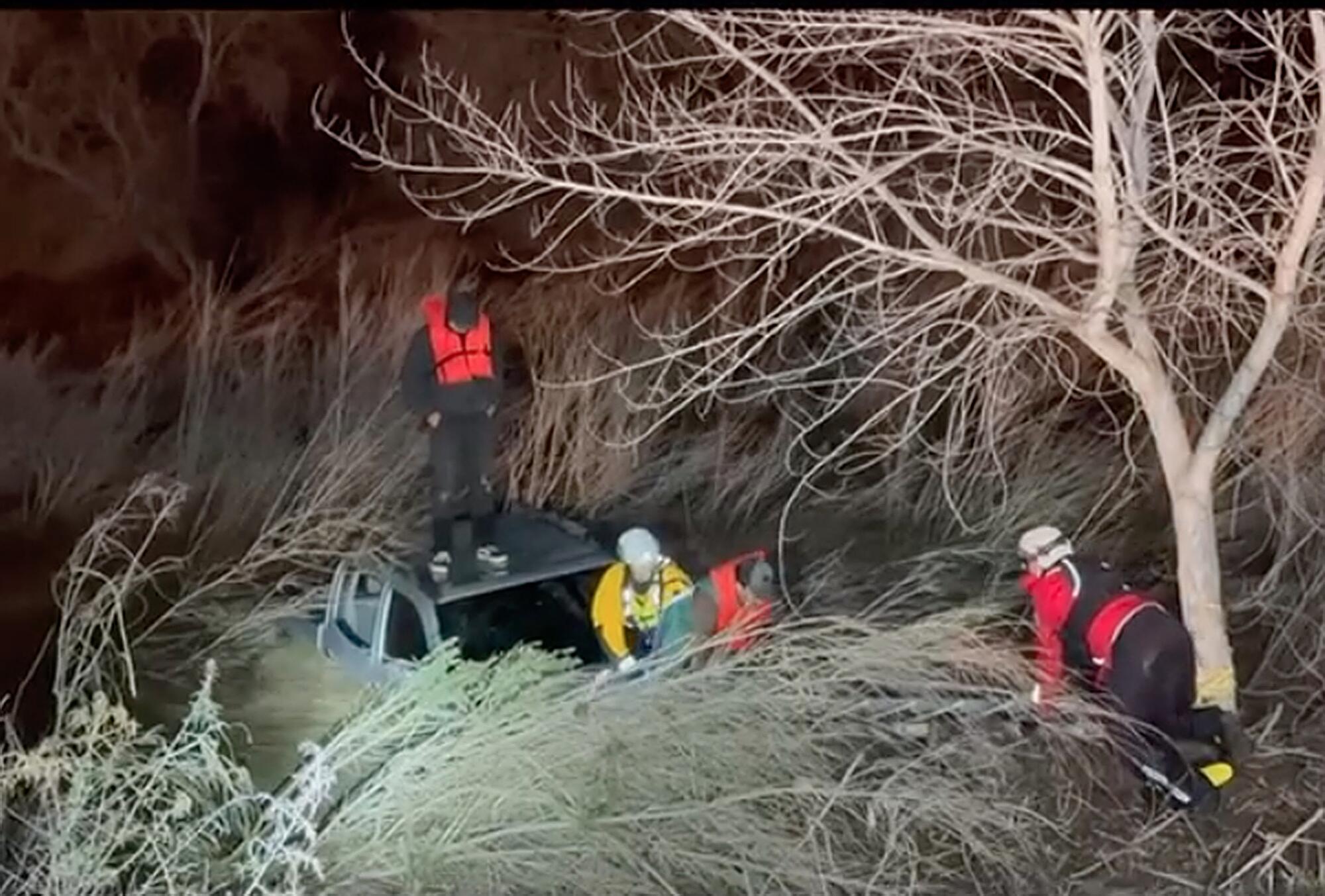
The team came up with a plan to use the Hollister Fire Department’s ladders and create a bridge across the water. They tipped over a 24-foot extension ladder from the shore to a small island in the water and crawled across the rungs.
It was Geoff Gray’s first time crossing over water on a ladder. He estimated that the water beneath him was flowing at 20 mph.
“You’re only inches off the water as the water is moving by swiftly,” said Gray, a captain/paramedic with the Alameda Fire Department and a member of the team. “You just start doing what you know, even though it’s a little bit different than what you’ve done before.”
Cassie Kays, a rescue specialist on the team, likened the experience to a ladder climb at a carnival. As the Oakland firefighter made her way across the river, she carried a second ladder to extend from the island to the hood of the truck. On the end of the ladder the team had attached life vests for the men to use in case something went wrong.
Gray then crossed over to the truck and guided the men as they crawled across the ladder to the patch of land. From there, Kays led them across the next ladder to shore.
“I was relieved for them that we got them off safely. I was excited that we had a pretty successful mission,” Kays said. “I felt like it went pretty quickly and smoothly.”
Gray called the rescue a team effort with Hollister Fire, law enforcement and the swift water team.
The two men, who were uninjured, were later arrested for trespassing, according to the San Benito County Sheriff’s Office. The 21-year-old and 25-year-old were in a no-trespassing zone.
“I think they were driving down there just to off-road, just to see if they could make it across the river, and they didn’t know that the river levels were that high and the water was that rapid,” said Cmdr. Silvestre Yerena, with the sheriff’s office.
Some major roads remain closed because of flooding, rock slides and debris flows, while crews have responded to a significant mudslide in Studio City and a major sinkhole in Chatsworth.
In Southern California, the Ventura County fire department deployed two swift water teams of six members each to respond to incidents around the county. The Oxnard Fire Department also deployed a team.
During the storm that began Jan. 9, Ventura County fire agencies responded to 22 swift water calls and rescued more than 80 people.
That included more than a dozen people rescued from the Ventura River. The fire department used a 35-foot ladder to help people climb onto a bridge.
“We haven’t had any swift water issues for the last three or four years or anything major like we’ve had the last few days,” said Capt. Tom Lanski, with the Ventura County Fire Department’s swift water rescue team. “We just haven’t had the rain, our rivers were pretty dry. There was just no water flowing anywhere in Southern California.”
On Monday, the team fielded calls from about noon until 2 a.m., Lanski said. The teams “were nonstop, it was just go, go go.”
That evening, Lanski’s team learned that a woman had gotten stuck on Camp Chaffee Road.
As the team tried to navigate to her, mudslides forced them to leave their boats behind. They encountered mud that was 5 feet deep and stretched 100 feet across the road.
“That was actually a pretty scary one, because we were going in an area that had had a bunch of sliding,” Lanski said. “You can’t see the hillside so you just don’t know if you’re going to be swept off the side any given second.”
When they reached the stranded woman, it was 9 or 10 p.m., and her truck was submerged in about 7 feet of water.
Jeff Whitehouse — dressed in a neon green and black dry suit and life jacket — had the job of swimming close to 100 feet to reach her. His team had hooked a rope onto his vest to pull him back if he got in trouble.
Whitehouse couldn’t see the woman through the pouring rain and darkness. He fought his way through the current, in water that was colder than 40 degrees, at one point bumping into a tree trunk that had washed downstream.
As he swam, he reached a palm tree and used it to pull himself toward the truck. He called out to the woman and then spotted her wedged in the fork of a tree, holding tight to its branches. He asked if she was OK. She told him she was cold and wet.
“She was definitely happy to see me,” he said.
Whitehouse hurried to help her put on a life vest. The water was rising, and time was of the essence.
The team used a canoe that had washed up nearby to get the woman to safety. Once she and Whitehouse were on board, a retrieval team helped guide the craft.
As soon as they reached land, they made sure the woman didn’t need medical attention. Then they loaded her into a vehicle, turned the heater on and got her out of there.
“We were just battling the weather,” Whitehouse recalled. “Visibility was probably the biggest challenge, just trying to locate her. We made it work.”
That same night, the county’s other swift water rescue team saved four people from a car stuck in the middle of a creek. The team laid a 14-foot ladder over raging water and onto the corner of the vehicle’s hood.
With more storms forecast in coming days, teams were deployed again Friday night. They’d be on call for any swift water that broke out.
And they were ready to start all over again.
- Share via
Watch L.A. Times Today at 7 p.m. on Spectrum News 1 on Channel 1 or live stream on the Spectrum News App. Palos Verdes Peninsula and Orange County viewers can watch on Cox Systems on channel 99.
More to Read
Sign up for Essential California
The most important California stories and recommendations in your inbox every morning.
You may occasionally receive promotional content from the Los Angeles Times.

